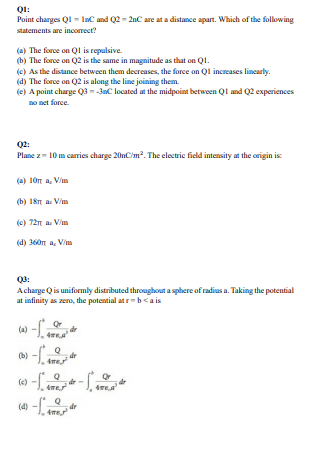QI: Point charges QI = laC and Q2- 2nC are at a distance apart. Which of the following statements are incomect? (a) The force on Ql is repulsive. (b) The force on Q2 is the same in magnitude as that on QI. (e) As the distance between them decreases, the force on Ql increases lincarly. (d) The force on Q2 is along the line joining them. (e) A point charge Q3 - -3aC located at the midpoint between QI and Q2 experiences no net force.
QI: Point charges QI = laC and Q2- 2nC are at a distance apart. Which of the following statements are incomect? (a) The force on Ql is repulsive. (b) The force on Q2 is the same in magnitude as that on QI. (e) As the distance between them decreases, the force on Ql increases lincarly. (d) The force on Q2 is along the line joining them. (e) A point charge Q3 - -3aC located at the midpoint between QI and Q2 experiences no net force.
Introductory Circuit Analysis (13th Edition)
13th Edition
ISBN:9780133923605
Author:Robert L. Boylestad
Publisher:Robert L. Boylestad
Chapter1: Introduction
Section: Chapter Questions
Problem 1P: Visit your local library (at school or home) and describe the extent to which it provides literature...
Related questions
Question

Transcribed Image Text:Q1:
Point charges Q1 - lnC and Q2 - 2nC are at a distance apart. Which of the following
statements are incorrect?
(a) The force on Ql is repulsive.
(b) The force on Q2 is the same in magnitude as that on Q1.
(c) As the distance between them decreases, the force on Ql increases linearly.
(d) The force on Q2 is along the line joining them.
(e) A point charge Q3 = -3aC located at the midpoint between Ql and Q2 experiences
no net force.
Q2:
Plane z= 10 m carries charge 20nCim?. The electric field intensity at the origin is
(a) 10n a, Vim
(b) 18m a V/m
(c) 72n a. Vim
(d) 360m a, Vim
Q3:
Acharge Q is uniformly distributed throughout a sphere of radius a. Taking the potential
at infinity as zero, the potential at rb<a is
-), a
dr
(b)
4me
dr
6) -L
(<)
dr
(a) -), am
dr
4me
Expert Solution
This question has been solved!
Explore an expertly crafted, step-by-step solution for a thorough understanding of key concepts.
Step by step
Solved in 2 steps with 2 images

Knowledge Booster
Learn more about
Need a deep-dive on the concept behind this application? Look no further. Learn more about this topic, electrical-engineering and related others by exploring similar questions and additional content below.Recommended textbooks for you

Introductory Circuit Analysis (13th Edition)
Electrical Engineering
ISBN:
9780133923605
Author:
Robert L. Boylestad
Publisher:
PEARSON

Delmar's Standard Textbook Of Electricity
Electrical Engineering
ISBN:
9781337900348
Author:
Stephen L. Herman
Publisher:
Cengage Learning

Programmable Logic Controllers
Electrical Engineering
ISBN:
9780073373843
Author:
Frank D. Petruzella
Publisher:
McGraw-Hill Education

Introductory Circuit Analysis (13th Edition)
Electrical Engineering
ISBN:
9780133923605
Author:
Robert L. Boylestad
Publisher:
PEARSON

Delmar's Standard Textbook Of Electricity
Electrical Engineering
ISBN:
9781337900348
Author:
Stephen L. Herman
Publisher:
Cengage Learning

Programmable Logic Controllers
Electrical Engineering
ISBN:
9780073373843
Author:
Frank D. Petruzella
Publisher:
McGraw-Hill Education

Fundamentals of Electric Circuits
Electrical Engineering
ISBN:
9780078028229
Author:
Charles K Alexander, Matthew Sadiku
Publisher:
McGraw-Hill Education

Electric Circuits. (11th Edition)
Electrical Engineering
ISBN:
9780134746968
Author:
James W. Nilsson, Susan Riedel
Publisher:
PEARSON

Engineering Electromagnetics
Electrical Engineering
ISBN:
9780078028151
Author:
Hayt, William H. (william Hart), Jr, BUCK, John A.
Publisher:
Mcgraw-hill Education,